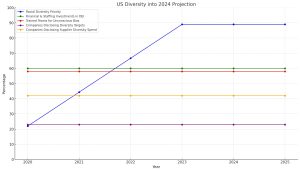Welcome to our ultimate guide on diversity. This guide examines diversity, equity, inclusion, and belonging (DEIB). Here, we will see what makes us unique and how these concepts shape our experiences and collective outcomes. We look at race, gender, ability, and more. Diversity is not just about the ‘big six’; we’ll dive into socioeconomic status, cultural backgrounds, and generational differences. Understanding diversity helps us in work, education, and life. Let’s explore inclusion and belonging together.
Understanding the Spectrum of Diversity
Moving beyond the “big six” dimensions of diversity (race, ethnicity, gender, sexual orientation, religion, and ability), we encounter complex factors shaping individual experiences. This spectrum includes socioeconomic status, veteran status, cultural background, neurodiversity, and generational differences. These intersecting elements affect how people perceive and interact with the world.
Socioeconomic Status
In the workplace, individuals from lower socioeconomic backgrounds may face challenges such as limited access to professional networks and mentorship opportunities. A study found that 62% of adults in lower-income households believe their economic background makes it harder to succeed in a career, compared to only 16% in upper-income households.
Cultural Background
Cultural diversity significantly affects students’ educational settings. Students from diverse cultural backgrounds bring unique perspectives and learning styles. Culturally responsive teaching improves student engagement and academic outcomes, particularly for minority students. To understand some of the challenges minority students face, check out our articles Struggles of Minority Students and A Closer Look at the issue.
Neurodiversity
In social settings, neurodiverse individuals, such as those with autism or ADHD, often experience difficulties in conventional social interactions. However, workplaces are increasingly recognizing the unique strengths of neurodiverse employees, like exceptional attention to detail or innovative problem-solving skills. Companies like Microsoft and JPMorgan Chase have initiated neurodiversity hiring programs, reporting increased productivity and innovation.
Veteran Status
Veterans often bring unique skills to the workplace, such as leadership and crisis management. However, they may also face challenges transitioning to a civilian work culture. Around 44% of veterans found this transition more difficult than expected, highlighting the need for supportive workplace policies.
Generational Variations
Generational differences can lead to diverse viewpoints and approaches in team settings. While Baby Boomers value loyalty and respect for authority, Millennials prioritize work-life balance and corporate social responsibility. Check out Bridging Generations because understanding these generational differences is critical for a collaborative and productive work environment.
These different aspects of diversity can significantly affect how individuals experience their environments. Understanding this diversity allows us to create more inclusive and equitable spaces for all.
Intersectionality in Professional Environments
This concept recognizes that individuals face unique challenges and discriminations based on these intersecting identities. Acknowledging and addressing these overlapping issues is crucial for creating inclusive and equitable workplaces.
- Challenges Faced by Asian Women: Asian women often encounter unique stereotypes at the intersection of racism and sexism. These stereotypes sometimes lead to them being perceived as submissive or rare, impacting their professional interactions and opportunities.
- Disability and LGBT Identity: Individuals who are both disabled and LGBT, like the TikTok star Stephen, often face a double burden of discrimination. Stephen’s experience highlights the tendency for one aspect of an intersectional identity, such as disability, to overshadow others, like sexual orientation.
- Black and Gay: Black gay individuals face compounded discrimination based on both their race and sexual orientation. This intersectionality can lead to their experiences being marginalized, particularly in contexts like health and social care, where research often focuses predominantly on white Western samples.
- Girls with ADHD: The intersection of gender and disability is evident in the diagnosis of ADHD. Girls with ADHD are often underdiagnosed compared to boys, as their symptoms, like chattiness or daydreaming, are overlooked, reflecting a gender bias in how ADHD is perceived and treated.
- Stereotypes about Gay Men: Gay men face unique stereotypes at the intersection of gender and sexual orientation. These stereotypes sometimes portray them as predators and are specifically targeted toward men and used to oppose initiatives like gay hate crime laws.
- Impact on Professional Success: The professional success of individuals with intersectional identities, like black women, can be significantly impacted by the compounded effects of their multiple marginalized identities. This can manifest in the form of racial and gender bias, both interpersonally and systemically, in professional settings.
Historical Origins and Evolution of Intersectionality
The concept of intersectionality was first coined by Kimberlé Crenshaw. Emphasizing how individual identities intersect and impact how people are viewed, understood, and treated. The idea has evolved to critique the limitations of traditional race, gender, and class theories, highlighting the need to know how disadvantages compound across different identity factors.
For further details and examples, check out these articles from Helpful Professor, Michael Mauro’s guide on intersectionality and Jopwell’s insights on the role of intersectionality in professional success.
Benefits of a Diverse World
The interconnectedness of diversity isn’t just beautiful; it’s vital for progress. Studies have shown that diverse teams:
- Boost creativity and innovation: By bringing together different perspectives and backgrounds, diverse teams generate a more comprehensive range of ideas and solutions.
- Enhance problem-solving and decision-making: Diverse viewpoints lead to more thorough analysis and consideration of alternative approaches, leading to better outcomes.
- Build more robust and resilient teams: Teams with varied experiences and skills are better equipped to handle challenges and adapt to change.
- Create fairer and more equitable social systems: When everyone has a voice and a seat at the table, policies and structures reflect the needs of the whole community.
Here are some insights from various sectors:
Technology Sector
The high-tech industry, while evolving rapidly, still shows trends of underrepresentation of certain groups, especially women. Despite this, there are pockets of improvement and examples where diversity has positively impacted business outcomes. Companies with diverse executive teams are more likely to have above-average profitability. Specifically, companies in the top quartile for gender diversity on executive teams were 25% more likely to have higher profitability than those in the fourth quartile. Similarly, companies with more ethnic and cultural diversity were 36% more likely to outperform their less diverse peers in profitability. This demonstrates a strong business case for diversity in corporate leadership, with the most varied companies increasingly likely to outperform less diverse ones.
Healthcare Industry
In healthcare, diversity is particularly crucial because it can directly influence patient care and health outcomes. Diverse healthcare teams are better equipped to address the varied needs of different patient populations, leading to more effective and culturally sensitive care. This can improve patient satisfaction and health outcomes, as healthcare providers who share or understand their patients’ cultural backgrounds can communicate more effectively and provide more personalized care.
Education Sector
Diverse faculty and student bodies enhance the educational experience by bringing various perspectives and ideas into the classroom. This exposure to different cultures and viewpoints fosters critical thinking and prepares students to thrive in a globalized world. Moreover, research has shown that diversity in educational settings can lead to more creative problem-solving and innovation. Diversity in education enriches the learning environment for all students, and there is a High Demand for Qualified Educators. Educators can have long-lasting positive impacts on the lives of their students.
Economic Growth and Societal Advancement
Diversity is a social imperative and a key driver of economic growth and societal advancement. Diverse workforces are more innovative and adaptable, which is crucial in today’s fast-paced global economy. Companies that embrace diversity are often more successful in penetrating new markets and adapting to changing consumer demands. Furthermore, diversity in leadership positions can lead to more equitable and inclusive decision-making processes, which benefit society by addressing systemic inequalities and fostering social cohesion. Source 1, Source 2
Challenges and Biases We Face
Our journey towards embracing diversity isn’t without obstacles. Unconscious bias, often ingrained in our social conditioning, can lead to unfair assumptions and discriminatory behavior. Stereotypes, which are oversimplified generalizations about groups of people, can breed prejudice and limit opportunities. Microaggressions, seemingly harmless yet hurtful comments or actions, can create a hostile environment for marginalized individuals.
Psychological Theories on Unconscious Bias
Unconscious biases are deeply ingrained prejudices that we’re often unaware of. They stem from various sources, including:
- Socialization and Cultural Influences: Biases are often developed during early life through social interactions, cultural norms, and media portrayals. They are reinforced by societal structures and institutions that perpetuate certain stereotypes.
- Cognitive Biases and Heuristics: Our brain’s tendency to take mental shortcuts and rely on past experiences leads to unconscious biases. This is rooted in our need to quickly process information and make decisions, often leading to generalized assumptions about groups of people.
- Group Dynamics: Ingroup bias, where individuals favor those who belong to their group, contributes significantly to unconscious bias. This can lead to stereotyping and prejudice against those perceived as belonging to an outgroup.
When Building a Diverse and Inclusive Workplace across different sectors, it is vital to consider the systemic barriers and psychological underpinnings that need to be addressed. Focusing on equity, inclusion, education, and awareness-raising about unconscious biases can help mitigate these issues.
Systemic Barriers in Different Sectors
Systemic barriers woven into the fabric of our institutions can disadvantage certain groups in areas like education, employment, healthcare, and housing.
- Wage Gaps: Wage disparities are a significant issue, often intersecting with race, gender, and educational background. For instance, men typically receive higher wage returns compared to women, and there are notable differences in pay based on race and academic fields. This suggests that wage gaps are not solely due to educational attainment but also reflect deep-rooted societal biases.
- Educational Disparities: The educational system often reflects and perpetuates systemic inequalities. A study highlighted that black and white children in the United States experience starkly different educational outcomes due to systemic economic inequality and segregated schools. These disparities are further exacerbated by factors like family background and neighborhood environment, which contribute significantly to academic achievement gaps.
For more in-depth information and analysis, you can refer to the studies and articles by Cornell University and the Economic Policy Institute, which provide comprehensive insights into these systemic barriers and their impacts.

Promoting Diversity and Inclusion
Creating a welcoming and inclusive environment requires more than good intentions. Here are some actionable strategies for individuals and organizations to promote diversity:
Developing Policies and Goals
- Develop a Diversity and Inclusion (D&I) Policy: Establish clear objectives for increasing diversity and fostering inclusion within your organization or community, like setting specific recruitment goals.
- Set Specific Goals: Include measurable targets to track progress.
Recruitment and Hiring Practices
- Diversify Recruitment: Seek candidates from underrepresented groups and utilize inclusive interviewing techniques.
- Review Job Descriptions: Ensure they all use inclusive, non-gendered language.
Education and Training
- Create Training Programs: Implement training programs for management to understand and champion diversity and inclusion. Then, focus on educating employees about unconscious bias, cultural competency, and respectful communication.
- Regular Awareness Activities: Conduct ongoing activities to keep awareness high.
Mentorship and Sponsorship
- Provide Mentorship Opportunities: Connect diverse individuals with experienced mentors and sponsors to advance their careers.
- Promote Sponsorship: Encourage leaders to actively support diverse employees’ career advancement.
Fostering an Inclusive Culture
- Build a Culture of Acceptance and Belonging: Encourage open communication, celebrate differences, and address discrimination effectively and immediately.
- Flexible Work Culture: Adapt to diverse needs, enabling employees to balance personal and professional responsibilities.
- Normalize Using Pronouns: Respect people’s pronouns and use them correctly in the workplace.
Additional Strategies
- Start Conversations: Regularly discuss diversity and inclusion topics.
- Increase Accountability: Implement transparent systems to track progress.
- Inclusive Leadership Skills: Train leaders to manage diverse teams effectively.
- Diverse Participation in Discussions: Ensure all voices are heard and valued.
- Act as a Vocal Ally: Support and stand up for underrepresented groups.
- Manage Unconscious Bias: Encourage awareness and proactive management of biases.
- Promote Pay Equity: Regularly review and adjust compensation structures.
- Acknowledge Cultural Holidays: Recognize and celebrate a variety of cultural events.
- Support Employee Resource Groups: Facilitate and encourage participation in groups that promote diversity.
- Mix-Up Teams: Create diverse teams for projects to encourage varied perspectives.
Execution and Follow-up
- Regular Feedback and Assessment: Continually seek feedback from all employees and assess the effectiveness of D&I initiatives.
- Community and External Engagement: Collaborate with diversity-focused organizations and communities to enhance efforts.
By implementing these strategies, organizations, and individuals can make significant strides in building a truly inclusive environment where diversity is recognized, celebrated, and leveraged for its many benefits. This approach promotes equity and drives innovation, creativity, and business success.

Case Studies: D&I in Action
Several organizations have implemented successful D&I initiatives, achieving remarkable results. One, in particular, stands out.
Google’s “Project Oxygen”
From 2009 to 2012, the project identified and addressed manager biases, improving employee retention and performance among women and other underrepresented groups.
- Being a good coach
- Empowering the team and not micromanaging
- Creating an inclusive team environment
- Focusing on productive behavior and results
- Communicating well
- Having a clear vision and strategy for the team
- Having key technical skill
This showcased the transformative power of a well-crafted D&I strategy.
The Role of Allies
Embracing diversity isn’t just about the marginalized; it requires active participation from everyone. Allies play a crucial role in:
- Speaking up against discrimination and injustice.
- Educating themselves and others about diversity and inclusion issues.
- Actively promoting opportunities for diverse individuals.
- Challenging their own biases and privilege.
Some Key Guidelines to Follow
- Active Listening and Empathy: Show genuine interest in your colleagues’ lives and work. Listen attentively and empathically to their experiences and ideas.
- Respect Identity and Culture: Acknowledge and respect individual identities, including pronouns and cultural or religious holidays. This shows attentiveness and care.
- Encourage Participation: Actively encourage everyone’s participation in team activities and meetings. If someone seems marginalized, check-in and offer support.
- Recognize Expertise and Skills: Individuals from underrepresented groups often have their skills and expertise undervalued. Acknowledge their contributions and provide opportunities for them to shine.
- Amplify Voices: Use your platform to amplify the ideas and stories of others, ensuring proper credit is given.
- Provide Quality Feedback: Offer regular and constructive feedback, focusing on skills and professional development rather than stereotypes or biases.
- Inclusion in Decision-Making: Invite diverse colleagues to speak and share their expertise, especially in settings where they are often underrepresented.
- Nonverbal Support: Even in virtual meetings, nonverbal cues can provide necessary support and feedback.
Common Mistakes to Avoid
- Assuming Knowledge: Avoid assuming you fully understand the experiences of marginalized groups.
- Performative Actions: Be genuine in your efforts rather than performing allyship for appearances.
- Overstepping Boundaries: Respect individual boundaries and avoid speaking over or for underrepresented groups.
Your Journey to Inclusion
Embracing diversity starts with introspection. Reflect on your own biases and privilege. Use self-assessment tools or honest conversations with diverse individuals to better understand your blind spots. Actively seek knowledge by reading books, watching documentaries, and engaging with people from different cultures and backgrounds. Remember, this journey is lifelong, and continuous learning is critical.
Taking Action in Your Daily Life
Small steps can create significant ripples. Here are some ways you can champion diversity in your everyday life:
- Support diverse businesses and organizations: Make conscious choices to spend money with companies owned by and catering to diverse communities. Donate to organizations working towards creating a more equitable world.
- Challenge discriminatory jokes and comments: Don’t be a bystander. Speak up against offensive language and behavior, even if it feels uncomfortable.
- Advocate for equitable policies: Contact your elected officials and urge them to enact policies that promote fairness and access for all, including initiatives combating discrimination, increasing educational opportunities, and closing the wealth gap.
- Volunteer your time and skills: Share your expertise and experience with organizations working on diversity and inclusion issues. Mentor young people from underrepresented backgrounds. Be a voice for positive change.
- Celebrate diversity in your personal life: Surround yourself with friends and colleagues from different backgrounds. Attend cultural events and learn about other traditions. Expand your horizons and embrace the richness of human experience.
Embracing diversity is not a single act but a continuous journey. It requires active effort, open-mindedness, and a commitment to learning and growing. By recognizing the benefits of diversity, challenging our biases, and taking action at all levels, we can create a world where everyone feels valued, respected, and empowered to reach their full potential.
Frequently Asked Questions
What are the “big six” dimensions of diversity?
The “big six” dimensions of diversity include race, ethnicity, gender, sexual orientation, religion, and ability. These primary categories are traditionally considered when discussing diversity but are not exhaustive.
How does socioeconomic status affect workplace diversity?
Individuals from lower socioeconomic backgrounds may face challenges like limited access to professional networks and mentorship opportunities, impacting their career advancement and inclusion in workplace diversity initiatives.
What is the significance of cultural diversity in educational settings?
Cultural diversity in education brings unique perspectives and learning styles, enhancing the learning environment. It fosters student engagement and academic outcomes, benefiting minority students through culturally responsive teaching.
How do generational differences impact the workplace?
Generational differences introduce diverse viewpoints and approaches in team settings. Understanding these differences, from Baby Boomers valuing loyalty to Millennials prioritizing work-life balance, is essential for fostering a collaborative and productive work environment.
What is intersectionality, and why is it important?
Intersectionality, coined by Kimberlé Crenshaw, refers to how different aspects of a person’s identity (like race, gender, and class) intersect and affect their experiences. Recognizing intersectionality is crucial for understanding individuals’ unique challenges and promoting more inclusive environments.
How does diversity contribute to innovation and economic growth?
Diverse teams boost creativity, enhance problem-solving, and are better equipped to adapt to change. Companies embracing diversity often see higher profitability, as varied perspectives drive innovation and help businesses adapt to changing consumer demands.
Conclusion
As we move forward, we need to remember:
- Diversity is not a problem to be solved but something to be embraced. Diversity holds immense value, offering new perspectives and enriching our collective understanding.
- Inclusion is the key that unlocks the potential of diversity. Creating an environment where everyone feels valued, heard, and empowered is essential.
- Change starts with us. We all have a role in dismantling discriminatory structures, challenging our biases, and advocating for equitable policies and practices.
- The journey is ongoing, but the destination is worth it. A world where everyone has the opportunity to thrive, regardless of their background, is a world worth building, brick by brick.
Let’s be the generation that breaks down the walls of division and builds bridges of understanding. Together, we can create a world of unity, progress, and shared prosperity. As we learn and grow, our knowledge and appreciation of what every individual brings will also. Embrace the journey, celebrate the differences, and work together to create a world where everyone feels like they belong.
Ready to dive deeper into diversity? Join us at Diversity Employment. Here, every story and voice adds value. Whether you seek knowledge or career opportunities, we welcome you.




